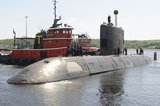Report: 'Sudden turn' by US warship led to collision
A ‘sudden turn’ by the American warship USS John S. McCain led to a collision with a tanker in 2017 off Singapore that left 10 sailors dead, a report by Singapore's Transport Ministry said on 8 March.
The ministry, releasing the results of its investigation into the incident, said a ‘series of missteps’ by the destroyer's crew and insufficient action by those of the tanker, the Alnic MC, contributed to the accident.
The vessels smashed into each other in the predawn hours of 21 August 2017 in the busy shipping lanes around the Strait of Malacca. There were no casualties among the tanker's crew.
The commander of the John S. McCain is facing charges including negligent homicide and dereliction of duty, the US Navy said in January 2018, after its own investigation into the incident found ‘multiple failures’ by the ship's crew.
Singapore said its 35-page report did not blame any organisation or individual for the fatal crash, but found the warship made an abrupt turn after a transfer of controls caused confusion among the crew.
The report said: ‘The collision... happened because of a sudden turn to port (left) by JSM (John S. McCain), which caused it to head into the path of the (tanker).’
It also noted that several sailors on watch at the John S. McCain during the collision had been assigned from another warship with steering control systems that were ‘significantly different’.
The report said: ‘These differences were not compensated for. Inadequacies in training and familiarisation before the task allocation may have contributed to the actions on John S. McCain.’
The collision took place within three minutes of the warship's sudden turn, it said, adding however that the actions taken by the tanker's crew ‘were insufficient to avoid’ the smashup.
The report added: ‘When the bridge team of Alnic MC saw the USS John S. McCain turning, it presumed that the (warship) would be able to safely pass ahead.’
The incident came after another destroyer, the USS Fitzgerald, smashed into a Philippine-flagged cargo ship off Japan in June 2017, leaving seven sailors dead.
In a report on the two separate collisions, US Chief of Naval Operations Admiral John Richardson said both were ‘preventable and the respective investigations found multiple failures by watch standers that contributed to the incidents’.
The US Navy said in November 2017 that the John S. McCain collision ‘resulted primarily from complacency, over-confidence and lack of procedural compliance’.
The US Navy said: ‘In particular, McCain's commanding officer disregarded recommendations from his executive officer, navigator and senior watch officer to set sea and anchor watch teams in a timely fashion.’
More from Naval Warfare
-
![How will SAFE shape naval procurement for Canada and its highest-receiving members?]()
How will SAFE shape naval procurement for Canada and its highest-receiving members?
Canada’s inclusion on the EU’s Security Action for Europe initiative is set to enhance the country’s defence procurement strategy with important implications for some of its naval programmes, while Poland and Romania have also secured significant SAFE funding.
-
![Thales wins DE&S contract for portable autonomous command centres]()
Thales wins DE&S contract for portable autonomous command centres
The agreement to provide portable autonomous command centres to the UK Royal Navy will enhance the service’s Mine Counter Measure operations and further integrate autonomous and uncrewed systems into its fleet.
-
![US Navy to conduct an experimentation campaign with emerging tech in 2026 and 2027]()
US Navy to conduct an experimentation campaign with emerging tech in 2026 and 2027
The Technology Operational Experimentation Events will inform future requirements as the US Navy looks for innovative solutions across three key operational domains.





















